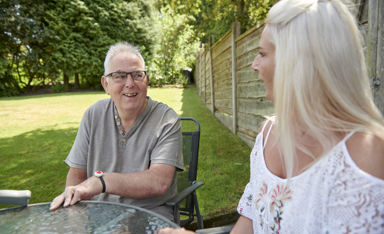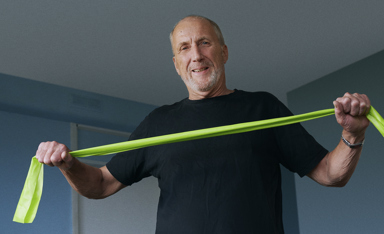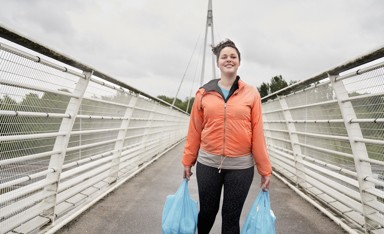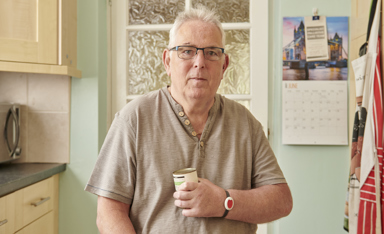Phil’s story
“The joke became who would learn to walk and talk first, me or my granddaughter, Olivia.”
Phil, a navy veteran, had been active his whole life right up until his stroke in 2016 left him paralysed down the left side of his body. With the help of physiotherapy exercises, Phil improved his mobility and was making great progress. With the encouragement and support of his children and grandchildren, Phil was finding ways to adapt after his stroke, like gaffer taping his foot to the exercise bike. To his disbelief, Phil was then diagnosed with a spinal tumour in 2020, giving him another hurdle to overcome.
Since the pandemic, Phil has been able to return to volunteering on the stroke ward at his local hospital, sharing his own experiences with patients and their families, encouraging them “to really focus on their rehab and exercise routines” as he found it a vital part of his own recovery.

Video transcript
Just over five and a half years ago, I had a severe stroke. I think I was doing quite well with my recovery until I found out that I had a tumour on my spine and at the same time they diagnosed that I had prostate cancer.
My wife Elaine was my initial carer, she did everything for me. Sadly, Elaine died 27 months ago unexpectedly. I still have friends who became quite important to me.
The only way I was going to recover was repetition in terms of exercise, taking out my trusty tin of mushrooms out of the cupboard, and then putting it back into the cupboard to exercise my arm.
My family wouldn't allow me to focus on self pity, and just literally took the Mickey out of me every single opportunity. So the family joke became who would walk and talk first, me or my one year old granddaughter Olivia - she won.
How Phil gets moving
Phil found that light exercise helped him feel ‘normal’ again after his stroke. He told himself that if he could get active and recover once, he could do it again. He was left unable to walk after surgery on his tumour, but starting with home exercises, he eventually managed to get back in the gym and is improving his mobility yet again. At the gym, he is pleased to meet other people with health conditions and exchange advice and motivation on staying active. On the days when he doesn’t feel quite up to the gym, Phil does small exercises like marching in place, which he learned from his time serving in the Navy, and religiously exercises using a can of mushrooms as a weight.
Phil has continued his rehabilitation and, after a period of inactivity due to pain in his hip, is now able to get back to the gym. He’s found that his confidence has improved as he’s become more active again, and he has been able to regularly see some local friends. Phil is also looking forward to a reunion with some old Navy comrades later this year.

Start slowly and build up
Even the smallest movement can have a positive impact on your long-term health. It might take some time, but once you find the right movements, they will help you get active and stay active.

Building activity into your routine
Getting active doesn’t need to be about doing traditional exercises. It can just be about doing things that fit into your daily routine, as and when you can. Building activity into your regular routine is one of the best ways you can start to build a new habit.

Stroke
Stroke affects everyone in different ways. This can include how your body works and how you think and feel. Being physically active after a stroke can be challenging because of fatigue or muscle weakness. But starting to move more can help with your recovery and wellbeing.
